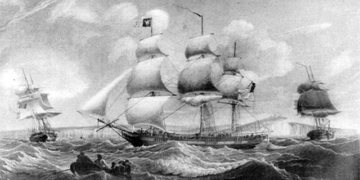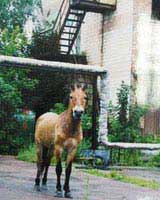 |
| The Przewalski horse is thriving in the contaminated area (Sergey Gaschak) |
The nuclear disaster that occurred two decades ago has transformed Chernobyl into one of the most heavily contaminated places on Earth. However, life was not extinguished; instead, it has become a shelter for a diverse range of wildlife, resembling a nature reserve.
The 30-kilometer exclusion zone surrounding the Chernobyl nuclear power plant is experiencing a remarkable resurgence. This revival is attributed to animals moving in once humans evacuated after the explosion, turning the contaminated area into their paradise.
Species that had been absent for decades, such as wildcats and large owls, are returning to the Chernobyl region. Mysteriously, tracks of a bear, a predator that has not roamed this part of Ukraine for centuries, have also been discovered.
Ecologist Sergey Gaschak asserts, “Animals seem to have no sense of radiation and they will dominate this area regardless of the radiation levels. Many birds are nesting right on the concrete sarcophagus.”
|
Residents of the Chernobyl exclusion zone |
| Reappearing species: Wildcat, owl, great egret, swan, and possibly a bear. Introduced species: European bison, Przewalski horse. Mammals increasing in number: Badger, beaver, wild boar, deer, moose, fox, hare, otter, feral dog, wolf. Birds increasing in number: Eurasian tree sparrow, corn bunting (with dark crown), black grouse, black stork, crane, white-tailed eagle. |
He refers to a massive structure of concrete and steel erected to encase the reactor that exploded in 1986.
“I have seen nests of starlings, pigeons, swallows, and redstarts, and even found their eggs,” the scientist adds.
While plutonium may still exist in the area, there are no herbicides, pesticides, industrial activities, or traffic. Therefore, nothing disturbs the wild boar population, which has increased eightfold in Chernobyl from 1986 to 1988, apart from another recovering predator—the wolf.
Pollution
However, the natural life in the area was not as bright in the initial months following the nuclear disaster due to much higher radiation levels at that time. Approximately 4 square kilometers of pine forest adjacent to the reactor turned color and died, earning it the name “Red Forest.”
Some animal species in the most heavily affected areas either died or ceased to reproduce. The embryos of certain rodents disintegrated, while the horses left on an island about 6 kilometers from the plant also perished due to their thyroid glands being destroyed.
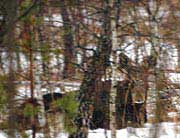 |
|
A moose glimpsed in the forest (BBC). |
The livestock on that island also stunted in growth due to thyroid damage. However, their next generation astonished observers with their completely normal body parts.
Nevertheless, the current characteristic of wildlife living in the contaminated area due to the Chernobyl disaster is that they are radioactive at levels unsafe for human consumption, despite being healthy.
Adaptation
A difference has emerged between species that inhabit a narrow area, such as rodents, and larger animals like moose, which tend to move continuously over a wide range and do not remain fixed in the contaminated zone.
Animals that roam large areas exhibit lower radiation levels compared to those trapped in hotspots of pollution. Nonetheless, there are signs that these less fortunate species may adapt to their living conditions.
Ecologist Sergey Gaschak has conducted numerous experiments on rodents captured in the Red Forest. The results indicate that they are slowly regaining their populations, even though the trees in the area remain stunted and deformed.
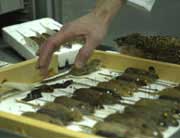 |
|
Rodents undergoing experimentation (BBC). |
“We marked the rodents in the contaminated area and released them, then recaptured them after a long time. We found that their lifespan is comparable to those in relatively clean areas,” Sergey stated.
The next step in the research is to introduce rodents from less contaminated areas into the Red Forest. “They seem not to feel well. Therefore, there is a clear difference between the rodents accustomed to living here and the newcomers,” Sergey concluded.
Mutations
In all of his studies, Sergey found only one rodent exhibiting symptoms akin to cancer. He discovered substantial evidence of DNA mutations, but these did not affect the physiological functions or reproductive abilities of the animals.
Mary Mycio, author of the book “Wormwood Forest,” which investigates wildlife in the Chernobyl area, points out that a mutated animal in the wild would typically die or be eaten before scientists could observe it.
Furthermore, she emphasizes that scientists generally study the overall population of a species rather than what happens to individual animals.
Nuclear storage
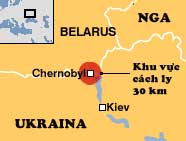 |
|
The exclusion zone spans both Ukrainian and Belarusian territory (BBC). |
Mary Mycio also assesses that the benefits nature has gained from human evacuation in the aforementioned area outweigh any damage caused by radiation exposure.
In her book, she quotes British environmentalist James Lovelock, who proposed the idea of storing nuclear waste from electricity generation in tropical forests or other habitats that, according to him, “are in need of protection from the destruction caused by greedy development planners.”
A vast area isolated after the Chernobyl disaster, located in Belarus, has officially been transformed into a nature reserve. Ecologist Sergey Gaschak hopes Ukraine will follow this model, turning their 2,500 square kilometers of exclusion zone into a reserve or national park.
Unlike the Ukrainian Greens, scientist Sergey is not concerned or opposed if the government implements plans to build a deep repository in the area to store nuclear waste from across the country.
Dinh Chinh

















































